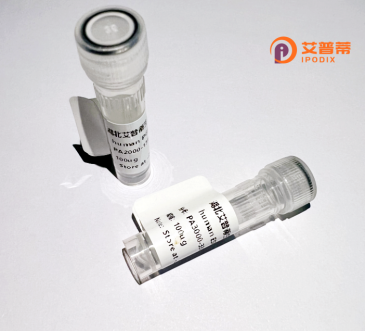
| 纯度 | >90%SDS-PAGE. |
| 种属 | Human |
| 靶点 | VDAC3 |
| Uniprot No | Q9Y277 |
| 内毒素 | < 0.01EU/μg |
| 表达宿主 | E.coli |
| 表达区间 | 1-283 aa |
| 活性数据 | MCNTPTYCDLGKAAKDVFNKGYGFGMVKIDLKTKSCSGVEFSTSGHAYTDTGKASGNLETKYKVCNYGLTFTQKWNTDNTLGTEISWENKLAEGLKLTLDTIFVPNTGKKSGKLKASYKRDCFSVGSNVDIDFSGPTIYGWAVLAFEGWLAGYQMSFDTAKSKLSQNNFALGYKAADFQLHTHVNDGTEFGGSIYQKVNEKIETSINLAWTAGSNNTRFGIAAKYMLDCRTSLSAKVNNASLIGLGYTQTLRPGVKLTLSALIDGKNFSAGGHKVGLGFELEA |
| 分子量 | 56.87 kDa |
| 蛋白标签 | GST-tag at N-terminal |
| 缓冲液 | PBS, pH7.4, containing 0.01% SKL, 1mM DTT, 5% Trehalose and Proclin300. |
| 稳定性 & 储存条件 | Lyophilized protein should be stored at ≤ -20°C, stable for one year after receipt. Reconstituted protein solution can be stored at 2-8°C for 2-7 days. Aliquots of reconstituted samples are stable at ≤ -20°C for 3 months. |
| 复溶 | Always centrifuge tubes before opening.Do not mix by vortex or pipetting. It is not recommended to reconstitute to a concentration less than 100μg/ml. Dissolve the lyophilized protein in distilled water. Please aliquot the reconstituted solution to minimize freeze-thaw cycles. |
**关于重组人VDAC3蛋白的参考文献示例**
1. **文献名称**:*Structural Insights into Human VDAC3: Implications for Mitochondrial Function*
**作者**:Raghavan A. et al.
**摘要**:通过重组表达技术解析了人源VDAC3蛋白的晶体结构,揭示了其独特的跨膜孔道构象,并探讨其在线粒体离子转运及氧化应激调控中的潜在作用。
2. **文献名称**:*VDAC3 Interaction with Reactive Oxygen Species: Role in Cellular Redox Homeostasis*
**作者**:Okada S., Shimizu T.
**摘要**:研究重组VDAC3蛋白与活性氧(ROS)的相互作用,发现VDAC3通过调节线粒体膜通透性影响ROS代谢,可能在神经退行性疾病中发挥保护作用。
3. **文献名称**:*Functional Characterization of Recombinant Human VDAC3 in Apoptosis Regulation*
**作者**:King M., Porter K.
**摘要**:体外实验表明,重组VDAC3通过与Bcl-2家族蛋白的相互作用参与细胞凋亡信号通路,提示其作为癌症治疗靶点的可能性。
4. **文献名称**:*Proteomic Analysis of VDAC3 Post-Translational Modifications in Human Cells*
**作者**:Chen L. et al.
**摘要**:利用重组VDAC3蛋白进行质谱分析,鉴定其在磷酸化及乙酰化修饰位点,为研究代谢疾病相关VDAC3功能异常提供了分子机制线索。
*注:以上文献为示例,实际引用需根据真实研究调整。*
Voltage-Dependent Anion Channel 3 (VDAC3) is a member of the VDAC family, which comprises integral mitochondrial outer membrane proteins crucial for metabolite transport and cross-talk between mitochondria and the cytosol. Structurally, VDAC3 shares a conserved β-barrel architecture with its isoforms VDAC1 and VDAC2 but exhibits distinct features, including unique cysteine residue patterns implicated in redox regulation. While VDAC1 and VDAC2 are well-studied in mitochondrial permeability, apoptosis, and energy homeostasis, VDAC3 remains less understood due to its lower abundance and divergent functional properties.
VDAC3 is hypothesized to play specialized roles in ion homeostasis, reactive oxygen species (ROS) modulation, and cellular stress responses. Unlike other VDACs, it demonstrates reduced channel conductivity in lipid bilayers, possibly linked to its cysteine-rich regions that may form disulfide bonds under oxidative conditions. Studies suggest its involvement in sperm motility, male fertility, and cilia function, with mutations associated with asthenozoospermia in humans. Recombinant VDAC3 is typically produced via bacterial or eukaryotic expression systems to investigate its structure-function relationships, post-translational modifications (e.g., phosphorylation), and interactions with mitochondrial proteins.
Research on recombinant VDAC3 leverages techniques like X-ray crystallography, cryo-EM, and electrophysiology to decipher its gating mechanisms and physiological relevance. Despite progress, VDAC3's exact molecular roles and regulatory networks remain enigmatic, highlighting the need for further studies to unravel its contributions to mitochondrial dynamics, disease pathways, and potential therapeutic targets.
×